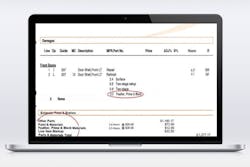AudaExplore Feather, Prime and Block Labor Estimating Tool
HOW IT WORKS:
It’s a constant struggle for any body shop, says Chris Agresto.
“People come in and say, ‘Why is it so many hours to paint a little square of metal? How could it possibly take that long?’” he says. “It’s not just painting. It’s repairing, sanding, priming and then painting and then more sanding. They don’t understand that.”
Beyond that, he says that this conversation is also often difficult with insurance adjusters.
As a technician at Nations Lighthouse Body Shop in Sterling, Va., Agresto says it’s a conversation that comes up nearly every day, particularly with feather, prime and block (FP&B) labor estimates. Although FP&B are required operations during the repair process and classified as refinish hours, most solution providers do not provide a labor time allowance for FP&B, as it’s typically a judgment time, says Agresto.
That’s why AudaExplore’s new FP&B labor estimating tool update has been such a welcome addition to the shop’s Audatex subscription.
“It was immediately obvious that it was genius to have it put there,” Agresto says. “It’s very helpful to us as
estimators.”
USES: Provides a labor time allowance for FP&B
TRAINING REQUIRED: None
Because it’s integrated directly into the Audatex program, Agresto says he simply has to indicate the area for repair and the number of hours to repair, and he is able to assign the time between block and feather.
“I can say, ‘That’s going to be 2.7 hours for the general repair, 1.7 for priming and buffing,’” he says. “It helps break down into how many hours we are spending on that activity, as opposed to a general, nebulous repair time. We weren’t able to do that at all before. It was just under one generic repair.”
Agresto says that many of the repairs can be set to automatic population, as well, which saves significant time.
“The thing that we like about it is that it helps increase the level of transparency for our customers, whether it’s an insurance claim or a private job,” he says. “This helps to break down what it is that we are doing for them.”
THE RETURN:
Although Agresto did not have to purchase the tool, he says that he’s immediately seen a return in the four months since he started using it, particularly during conversations with insurance adjusters.
“I find that this is helpful with the insurance adjusters,” he says. “When I say this takes four hours and they say we can do it quicker, I can say no. It’s helping me justify my times with the insurance guys. That’s helpful for me as a shop.”
He says it has also helped close more sales with customer-pay jobs, as he is better able to explain the cost of
the repairs.
“If you come in as a private client with no liability coverage and now I’m handing you an estimate with all of these times and information, you can see that, ‘Wow these guys are really doing a lot of work,’” he says. “It bumps it up and now it’s a quarter-page of stuff we’re doing to your car. Now when I’m giving you the colossally large number at the bottom of the page, it seems more justified.”
